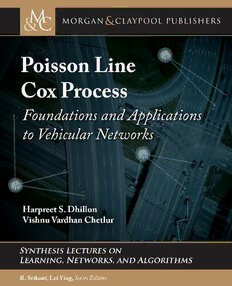Table Of ContentSeries ISSN: 2690-4306
D
H
Synthesis Lectures on I
L
L
Learning, Networks, and Algorithms O
N
•
C
H
E
T
Series Editors: R. Srikant, University of Illinois at Urbana-Champaign
L
U
Lei Yang, University of Michigan, Ann Arbor R
Poisson Line Cox Process
FHaoruprneedt aS.t Diohnillso na, nVidrg iAniap Tpeclhications to Vehicular Networks
Vishnu Vardhan Chetlur, Virginia Tech
This book provides a comprehensive treatment of the Poisson line Cox process (PLCP) and its applications to P
O
vehicular networks. The PLCP is constructed by placing points on each line of a Poisson line process (PLP) as I
S
per an independent Poisson point process (PPP). For vehicular applications, one can imagine the layout of the S
O
road network as a PLP and the vehicles on the roads as the points of the PLCP. First, a brief historical account N
of the evolution of the theory of PLP is provided to familiarize readers with the seminal contributions in this L
I
area. In order to provide a self-contained treatment of this topic, the construction and key fundamental properties N
E
of both PLP and PLCP are discussed in detail. The rest of the book is devoted to the applications of these C
models to a variety of wireless networks, including vehicular communication networks and localization networks. O
X
Specifically, modeling the locations of vehicular nodes and roadside units (RSUs) using PLCP, the signal-to- P
interference-plus-noise ratio (SINR)-based coverage analysis is presented for both ad hoc and cellular network R
O
models. For a similar setting, the load on the cellular macro base stations (MBSs) and RSUs in a vehicular C
network is also characterized analytically. For the localization networks, PLP is used to model blockages, which is E
S
shown to facilitate the characterization of asymptotic blind spot probability in a localization application. Finally, S
tqs huuege gspteaisotthnio sdBn iisasn tso aentndh c feleua tcraughrreeaealry sad coiotrnefe r cttitrshiatoeinnc sossp r foioogfrr it rnaae atssilepo arenerc csinehaael. rtccwahso ero kofs ft PhanLe dCa uPutr haboraerns a, nptahlaliynsz niesid nt,g hw.e hTh fiicrehs t b cbaoonoo kbk e i tslh ecvaoet nrsacpgleuecddi fietdoc a awlnlyist whfo eccruo csnreicstri ecotanel
the self-contained mathematical treatment of the PLCP. The ideal audience of this book is graduate students
apso iwnet lpl raos creessseeasr, cahnedr sa irne ianctaedreemsteiad ainnd t hine dfiuesltdr yo fw shtoo cahraes ftaicm gielioamr wetirtyh apnrdo bvaebhiilcituyl atrh neoertwy, ohrakvse. Gsoimveen e txhpeo dsuivreer tsoe
backgrounds of the potential readers, the focus has been on providing an accessible and pedagogical treatment of
this topic by consciously avoiding the measure theoretic details without compromising mathematical rigor. M
O
About Synthesis
R
G
This volume is a printed version of a work that appears in the Synthesis Digital Library of Engineering A
and Computer Science. Synthesis books provide concise, original presentations of important research and N
development topics, published quickly, in digital and print formats. &
C
L
A
Y
P
O
store.morganclaypool.com O
L
Poisson Line Cox Process
Foundations and Applications to Vehicular Networks
Synthesis Lectures on
Learning, Networks, and
Algorithms
Editor
LeiYing,UniversityofMichigan,AnnArbor
EditorEmeritus
R.Srikant,UniversityofIllinoisatUrbana-Champaign
FoundingEditorEmeritus
JeanWalrand,UniversityofCalifornia,Berkeley
SynthesisLecturesonLearning,Networks,andAlgorithmsisanongoingseriesof75-to150-page
publicationsontopicsonthedesign,analysis,andmanagementofcomplexnetworkedsystems
usingtoolsfromcontrol,communications,learning,optimization,andstochasticanalysis.Each
lectureisaself-containedpresentationofonetopicbyaleadingexpert.Thetopicsincludelearning,
networks,andalgorithms,andcoverabroadspectrumofapplicationstonetworkedsystems
includingcommunicationnetworks,data-centernetworks,social,andtransportationnetworks.
Theseriesisdesignedto:
• Providethebestavailablepresentationsofimportantaspectsofcomplexnetworkedsystems.
• Helpengineersandadvancedstudentskeepupwithrecentdevelopmentsinarapidly
evolvingfieldofscienceandtechnology.
• Facilitatethedevelopmentofcoursesinthisfield.
PoissonLineCoxProcess:FoundationsandApplicationstoVehicularNetworks
HarpreetS.DhillonandVishnuVardhanChetlur
2020
AgeofInformation:ANewMetricforInformationFreshness
YinSun,IgorKadota,RajatTalak,andEytanModiano
2019
Multi-ArmedBandits:TheoryandApplicationstoOnlineLearninginNetworks
QingZhao
2019
iv
DiffusionSourceLocalizationinLargeNetworks
LeiYingandKaiZhu
2018
CommunicationsNetworks:AConciseIntroduction,SecondEdition
JeanWalrandandShyamParekh
2017
BATSCodes:TheoryandPractice
ShenghaoYangandRaymondW.Yeung
2017
AnalyticalMethodsforNetworkCongestionControl
StevenH.Low
2017
AdvancesinMulti-ChannelResourceAllocation:Throughput,Delay,andComplexity
BoJi,XiaojunLin,andNessB.Shroff
2016
APrimeronPhysical-LayerNetworkCoding
SoungChangLiew,LuLu,andShengliZhang
2015
SharingNetworkResources
AbhayParekhandJeanWalrand
2014
WirelessNetworkPricing
JianweiHuangandLinGao
2013
PerformanceModeling,StochasticNetworks,andStatisticalMultiplexing,Second
Edition
RaviR.Mazumdar
2013
PacketswithDeadlines:AFrameworkforReal-TimeWirelessNetworks
I-HongHouandP.R.Kumar
2013
Energy-EfficientSchedulingunderDelayConstraintsforWirelessNetworks
RandallBerry,EytanModiano,andMurtazaZafer
2012
NSSimulatorforBeginners
EitanAltmanandTaniaJiménez
2012
v
NetworkGames:Theory,Models,andDynamics
IshaiMenacheandAsumanOzdaglar
2011
AnIntroductiontoModelsofOnlinePeer-to-PeerSocialNetworking
GeorgeKesidis
2010
StochasticNetworkOptimizationwithApplicationtoCommunicationandQueueing
Systems
MichaelJ.Neely
2010
SchedulingandCongestionControlforWirelessandProcessingNetworks
LibinJiangandJeanWalrand
2010
PerformanceModelingofCommunicationNetworkswithMarkovChains
JeonghoonMo
2010
CommunicationNetworks:AConciseIntroduction
JeanWalrandandShyamParekh
2010
PathProblemsinNetworks
JohnS.BarasandGeorgeTheodorakopoulos
2010
PerformanceModeling,LossNetworks,andStatisticalMultiplexing
RaviR.Mazumdar
2009
NetworkSimulation
RichardM.Fujimoto,KalyanS.Perumalla,andGeorgeF.Riley
2006
Copyright©2020byMorgan&Claypool
Allrightsreserved.Nopartofthispublicationmaybereproduced,storedinaretrievalsystem,ortransmittedin
anyformorbyanymeans—electronic,mechanical,photocopy,recording,oranyotherexceptforbriefquotations
inprintedreviews,withoutthepriorpermissionofthepublisher.
PoissonLineCoxProcess:FoundationsandApplicationstoVehicularNetworks
HarpreetS.DhillonandVishnuVardhanChetlur
www.morganclaypool.com
ISBN:9781681738420 paperback
ISBN:9781681738437 ebook
ISBN:9781681738444 hardcover
DOI10.2200/S01007ED1V01Y202004LNA024
APublicationintheMorgan&ClaypoolPublishersseries
SYNTHESISLECTURESONLEARNING,NETWORKS,ANDALGORITHMS
Lecture#24
Editor:LeiYing,UniversityofMichigan,AnnArbor
EditorEmeritus:R.Srikant,UniversityofIllinoisatUrbana-Champaign
FoundingEditorEmeritus:JeanWalrand,UniversityofCalifornia,Berkeley
SeriesISSN
Print2690-4306 Electronic2690-4314
Poisson Line Cox Process
Foundations and Applications to Vehicular Networks
Harpreet S. Dhillon and Vishnu Vardhan Chetlur
VirginiaTech
SYNTHESISLECTURESONLEARNING,NETWORKS,ANDALGORITHMS
#24
M
&C Morgan &cLaypool publishers
ABSTRACT
ThisbookprovidesacomprehensivetreatmentofthePoissonlineCoxprocess(PLCP)andits
applications to vehicular networks. The PLCP is constructed by placing points on each line of
aPoissonlineprocess(PLP)asperanindependentPoissonpointprocess(PPP).Forvehicular
applications,onecanimaginethelayoutoftheroadnetworkasaPLPandthevehiclesonthe
roadsasthepointsofthePLCP.First,abriefhistoricalaccountoftheevolutionofthetheory
ofPLPisprovidedtofamiliarizereaderswiththeseminalcontributionsinthisarea.Inorderto
provideaself-containedtreatmentofthistopic,theconstructionandkeyfundamentalproperties
ofbothPLPandPLCParediscussedindetail.Therestofthebookisdevotedtotheapplications
ofthesemodelstoavarietyofwirelessnetworks,includingvehicularcommunicationnetworks
andlocalizationnetworks.Specifically,modelingthelocationsofvehicularnodesandroadside
units (RSUs) using PLCP, the signal-to-interference-plus-noise ratio (SINR)-based coverage
analysisispresentedforbothadhocandcellularnetworkmodels.Forasimilarsetting,theload
onthecellularmacrobasestations(MBSs)andRSUsinavehicularnetworkisalsocharacterized
analytically.Forthelocalizationnetworks,PLPisusedtomodelblockages,whichisshownto
facilitatethecharacterizationofasymptoticblindspotprobabilityinalocalizationapplication.
Finally,thepathdistancecharacteristicsforaspecialcaseofPLCPareanalyzed,whichcanbe
leveragedtoanswercriticalquestionsintheareasoftransportationnetworksandurbanplanning.
Thebookisconcludedwithconcretesuggestionsonfuturedirectionsofresearch.
Basedlargelyontheoriginalresearchoftheauthors,thisisthefirstbookthatspecifically
focuses on the self-contained mathematical treatment of the PLCP. The ideal audience of this
bookisgraduatestudentsaswellasresearchersinacademiaandindustrywhoarefamiliarwith
probability theory, have some exposure to point processes, and are interested in the field of
stochastic geometry and vehicular networks. Given the diverse backgrounds of the potential
readers,thefocushasbeenonprovidinganaccessibleandpedagogicaltreatmentofthistopicby
consciouslyavoidingthemeasuretheoreticdetailswithoutcompromisingmathematicalrigor.
KEYWORDS
stochasticgeometry,PoissonlineCoxprocess(PLCP),Poissonlineprocess(PLP),
coverageprobability,vehicularnetworks,vehicularadhocnetwork(VANET),cel-
lularvehicle-to-everything(C-V2X)

